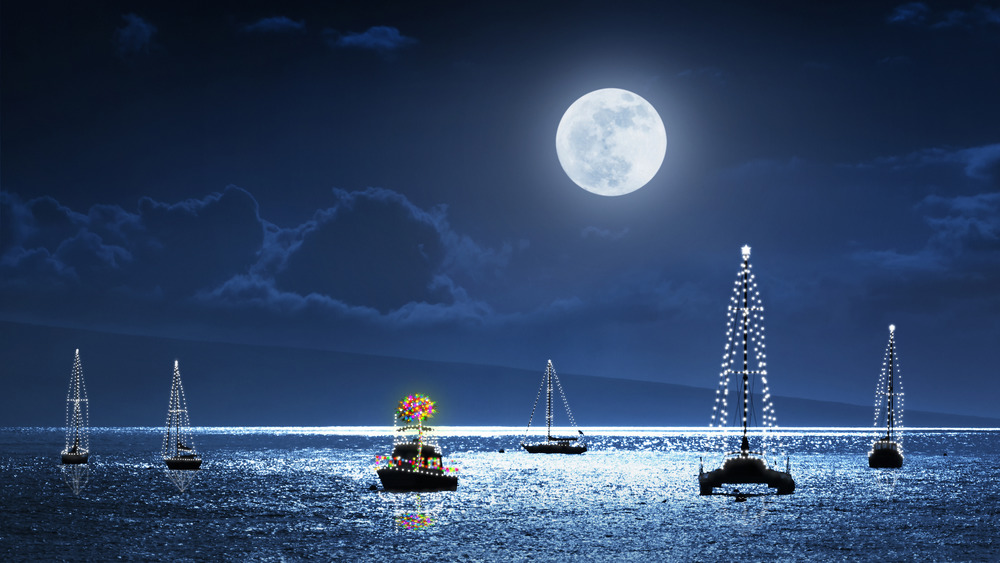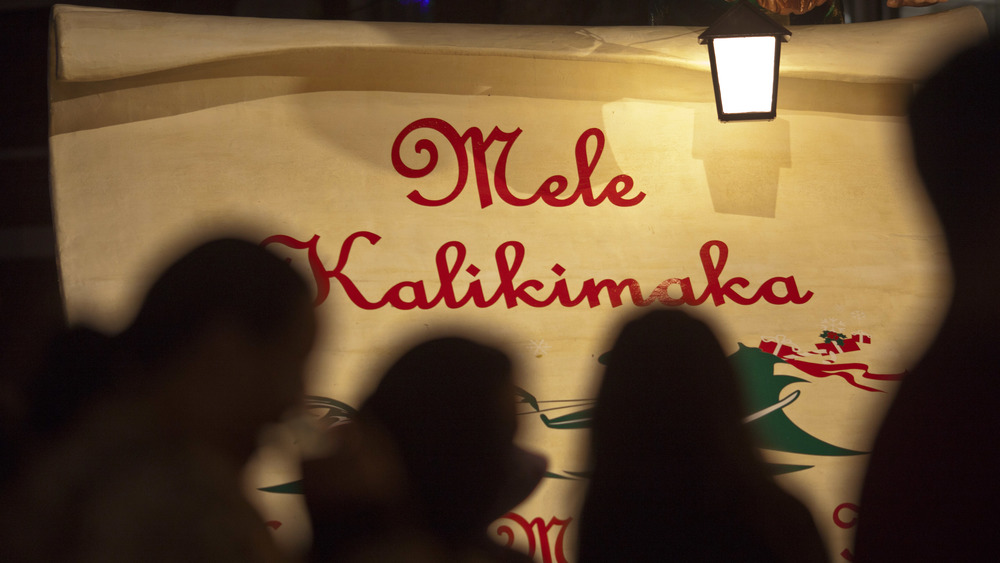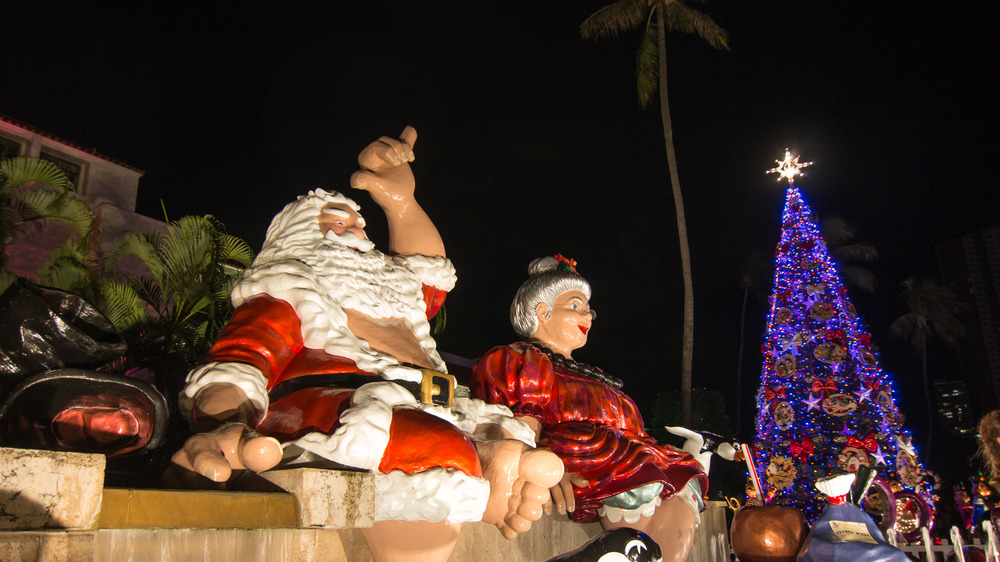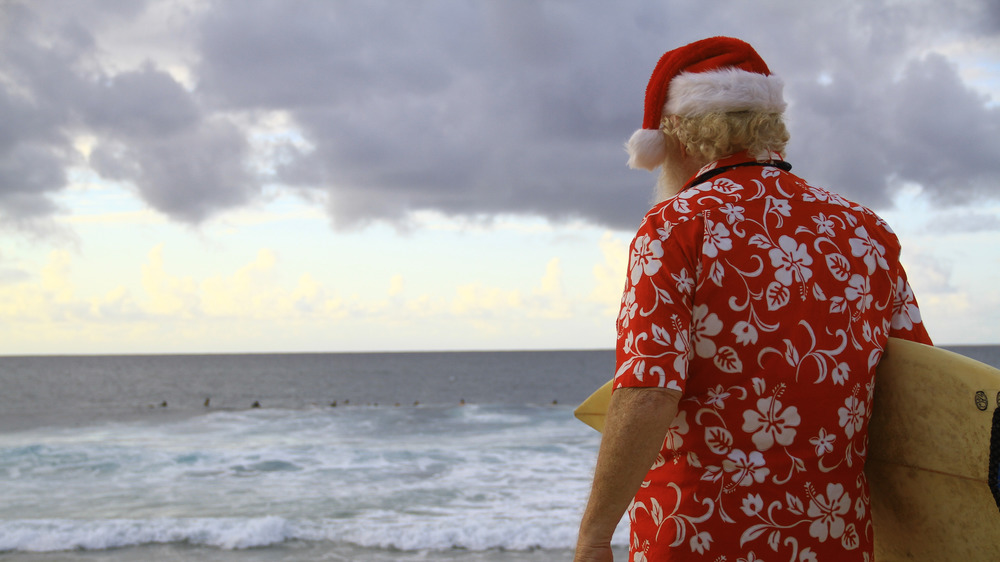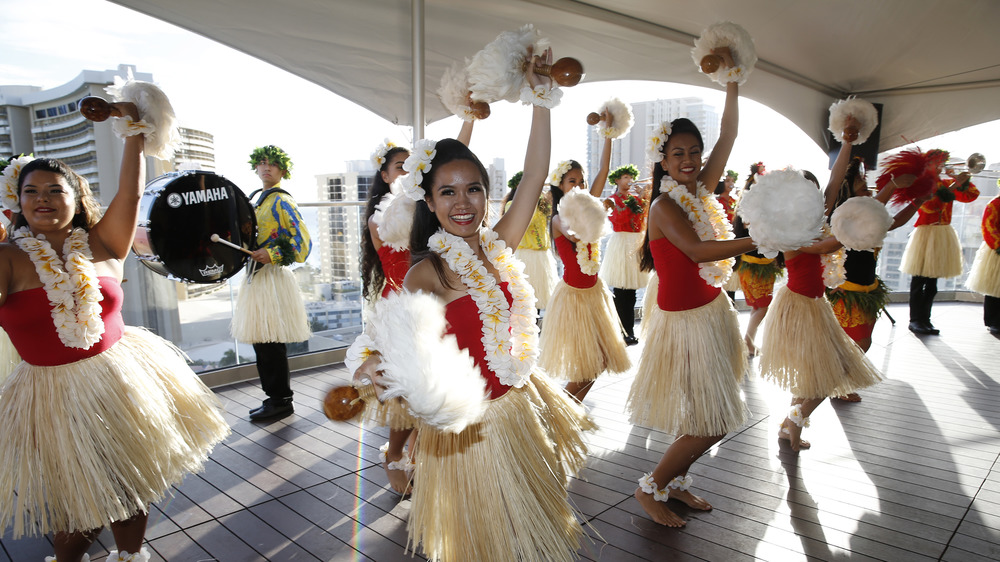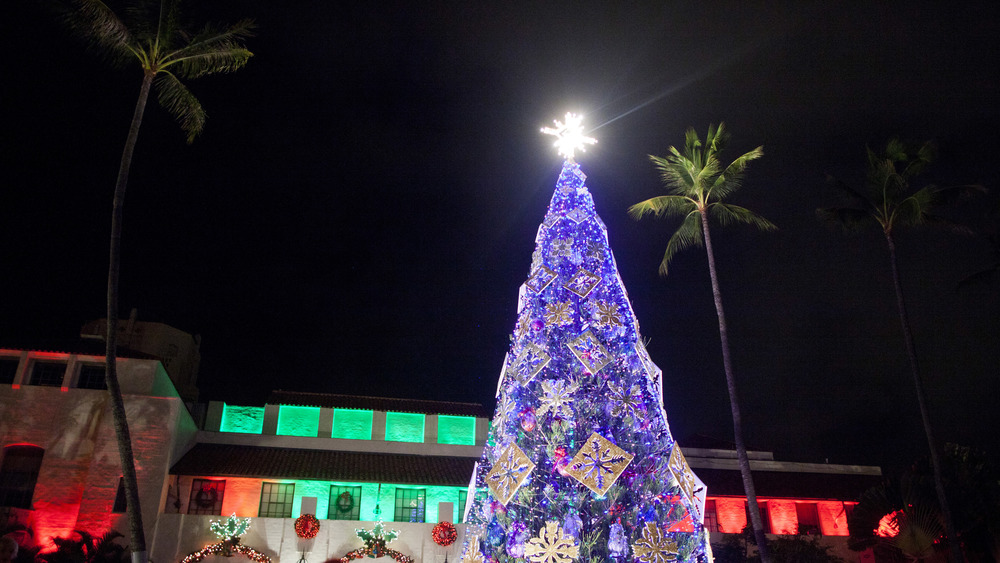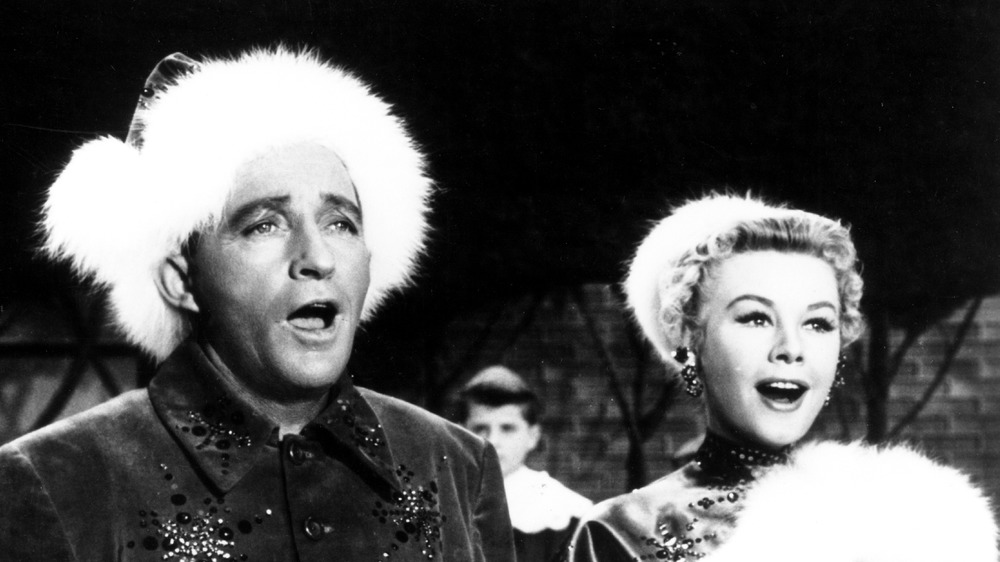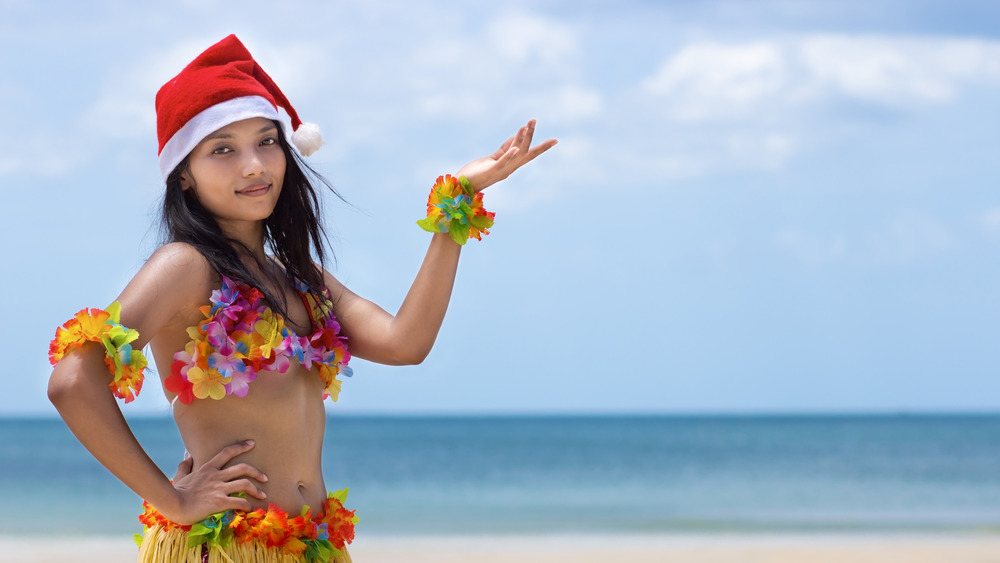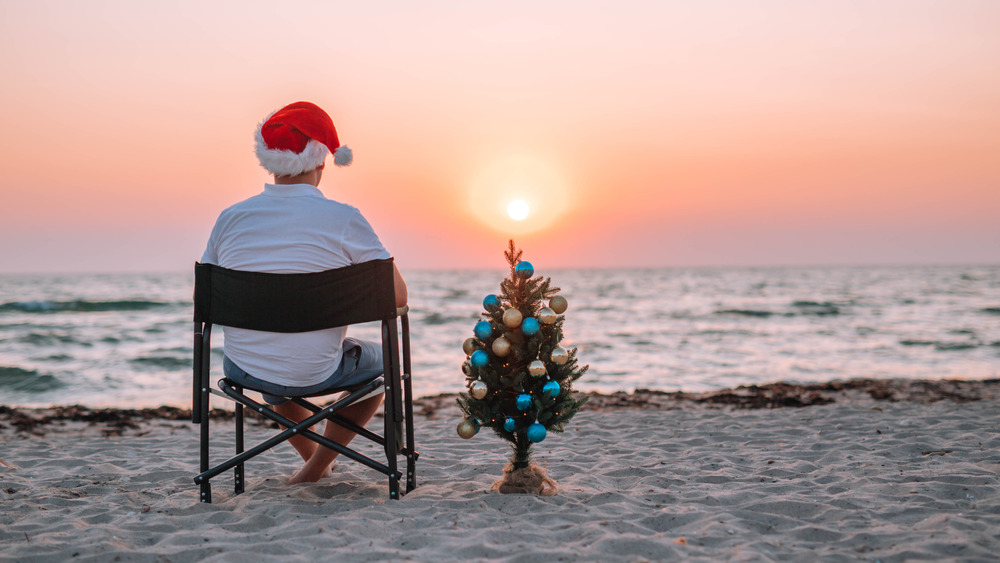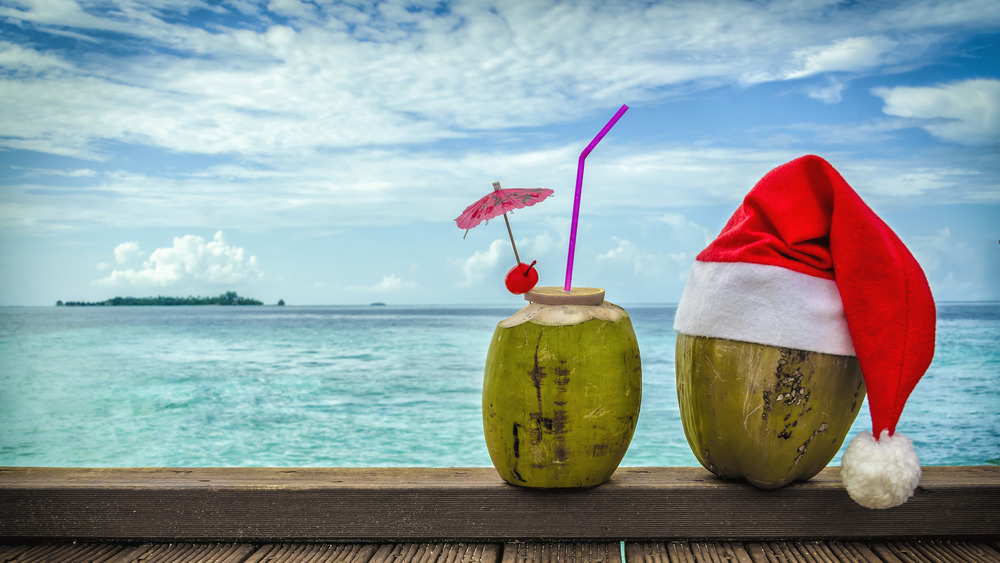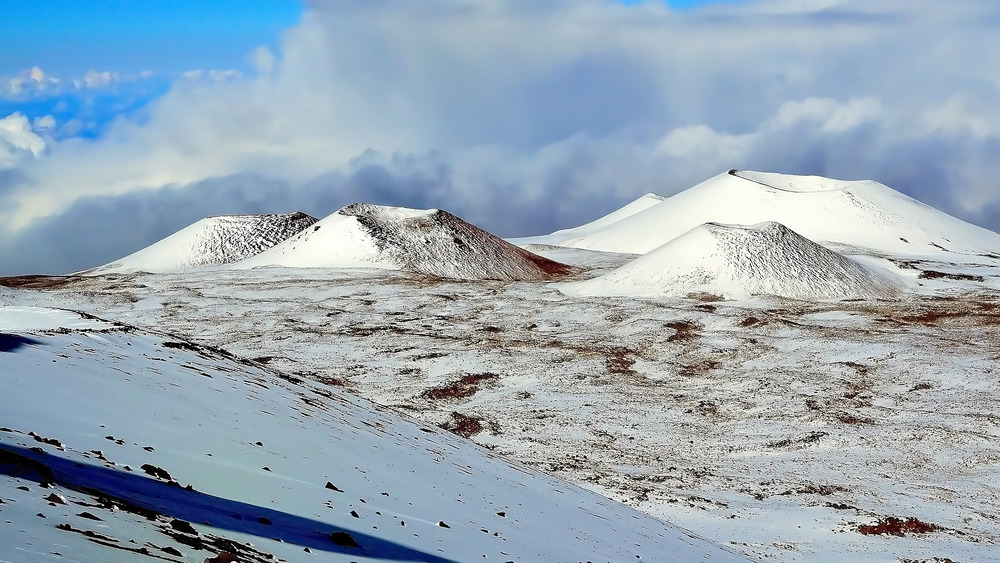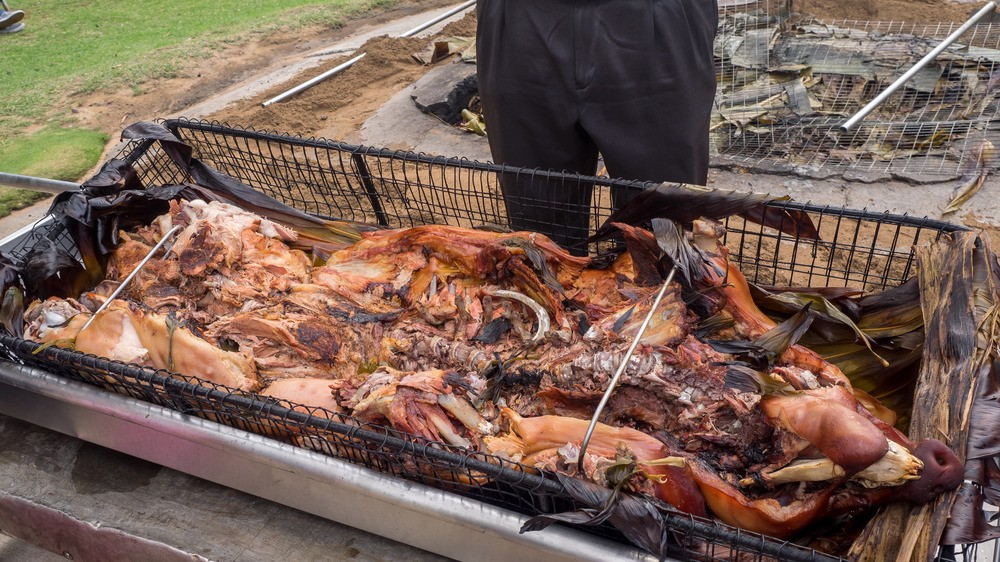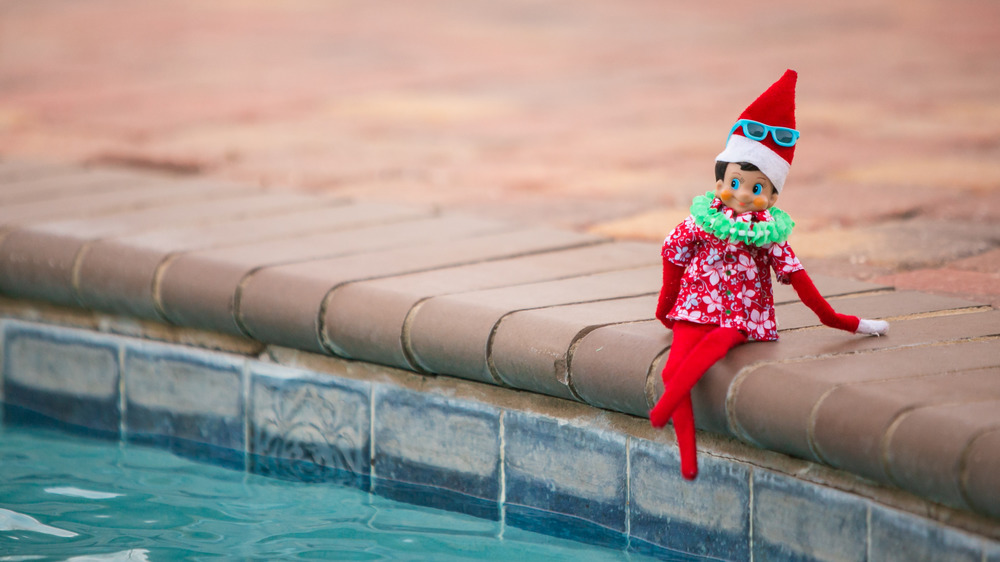What It's Really Like To Celebrate Christmas In Hawaii
Understandably, Christmas isn't a Hawaiian tradition. Hawaii didn't even gain statehood until 1959 (per the National Archives), though it had already had already been heavily influenced by American and British customs. Meanwhile, the first Christmas was likely celebrated in Rome back in the year 336. Hawaii had to catch up.
Today, Hawaii celebrates most quintessentially American holidays in the same way as its mainland counterparts, but there are still exceptions, such as Discoverer's Day taking the place of Columbus Day. Similarly, a Hawaiian Christmas isn't quite the same as Christmas on the mainland.
Though there might be gift-giving, carols, and even Christmas trees, a Hawaiian Christmas isn't going to have the snowy-white wonder of the colder climates. And because of the Hawaiian penchant for making everything a little bit more Hawaiian, a lot of the traditional mainstays of Christmas have been altered to take on a more tropical vibe.
So, let's take a look at what celebrating Christmas in Hawaii really means — both for the locals and the tourists who would like to celebrate with them.
You don't say Merry Christmas — you say Mele Kalikimaka
In Hawaii, you say "Mele Kalikimaka" rather than "Merry Christmas." But that's not actually Hawaiian — it's just as close to Hawaiian as it could get.
As noted by Professor David Strauch at the University of Hawaii at Manoa, the Hawaiian language only has 12 letters in its alphabet. "Mele Kalikimaka" is a direct phonetic rendering of "Merry Christmas," with Christmas having been imported in 1820 by the missionaries. These direct phonetic renderings are common, especially with names. For example, Amy becomes Ame, George becomes Keoki, Lisa becomes Lika, and Aaron becomes Aalona. It's popular for tourists to find their Hawaiian name when they go to visit Hawaii. If they go for Christmas, they may even be able to find their Hawaiian name on a stocking. The lack of letters in the Hawaiian language is what can also make many Hawaiian words feel somewhat inscrutable: The repetitive nature of the words can be difficult for non-native speakers to grasp.
Interestingly, the Polynesian languages are all very similar to each other despite large geographic gaps — but there are differences in which letters exist in which language. Hawaii doesn't have the "t" sound, but Tahitian does. Likewise, Tahitian replaces the "w" sound with the "v" sound. In Hawaiian, a woman is a "wahine" — in Tahitian, a woman is a "vehine."
Every year, Shaka Santa and Tutu Mele grace the town
Rather than Santa Claus and Mrs. Claus, Hawaii has Shaka Santa and Tutu Mele – giant figurines that are brought in every year. Shaka Santa is a bare-chested, bearded figure, while Tutu Mele shows up in a traditional Hawaiian muumuu. Shaka Santa has been part of the Hawaiian holiday tradition since 1989, when artist Kurt Nelson sculpted the Christmas icon, who sits at 21 feet tall and weighs two tons. As reported by Hawaii News Now, Tutu Mele was added in 1994.
"Shaka" is of fairly recent cultural origin and means "hang loose" or "right on." It's a friendly greeting that goes beyond the "okay" sign, essentially telling everyone that everything is good. There are many stories of the shaka's origin, but they're unverified — and the name of the shaka itself is not a Hawaiian word. Meanwhile, the "tutu" appellation in Tutu Mele refers to grandparents. The astute may recall that the letter "t" is not in the Hawaiian language. Traditionally, the word was kuku. This lingual drift likely happened after other cultures and other words were introduced into Hawaii.
But because the dynamics of Hawaiian families are extremely fluid (with entire villages raising children), the special distinctions between older family members aren't always important – most elders are grandparents or aunties and uncles.
Hawaii's Santa wears shorts and flip-flops — and rides dolphins
But Shaka Santa isn't the traditional Hawaiian depiction of Santa. According to Only In Your State, Hawaii's Santa wears shorts and flip-flops, and he rides dolphins rather than reindeer. Every year, commercials and flyers will feature this Hawaiian Santa.
Part of this makes sense. The traditional version of Santa wouldn't be apt to get anywhere in the heat of Hawaii. But flying reindeer can probably get pretty much anywhere. Nevertheless, Christmas traditions in Hawaii include things such as Santa arriving by outrigger canoe (and, were Santa a historical figure, that's probably how he would have gotten there).
When Santa appears for pictures (sometimes for children and sometimes for pets!) he also usually appears in a Hawaiian shirt rather than his traditional Christmas adornments. Just as on the mainland, Hawaiian Santa will pop up at malls and other public spaces so that good children are able to sit on his lap and ask for their Christmas presents.
On a more practical note, this means that Santa doesn't have to sit there in a velvet suit during 80-degree weather.
Hawaii's Christmas celebrations harken back to Makahiki
Though missionaries may have brought Christmas to Hawaii, there was a pre-existing celebration known as Makahiki, according to Hawaii History. Similar to Christmas, it was a time of peace and gift-giving. These Makahiki celebrations may have paved the way toward Christmas being accepted more readily by the natives.
Many aren't aware that Hawaii was the stage of quite a few battles, some fairly recent in long-term historical scale. Before Hawaii was taken by America, there had been major battles for Hawaiian unification — unification under the same king. Makahiki was important because it was a break in the warfare.
During Makahiki, farmers would stop farming and competitive games would be played – sort of a cross between Christmas and the Olympics. But perhaps the most impressive element of Makahiki was that it spanned a full three to four months of time. Thus, even during times of war, there was a significant break when everyone could recover and goodwill and gifts could be spread.
Makahiki is still celebrated today, but because the season is so long, people pick which days they want to celebrate. Games, foods, and other historic festivities are featured, and many usually wear traditional Hawaiian clothing.
Everyone goes to see the Honolulu City Lights to celebrate Hawaiian Christmas
Every year, a 50-foot tree is erected in the center of Honolulu, and the entire town is decorated with bright lights. Most families on Oahu will make a small pilgrimage to see the Honolulu City Lights once during the holiday season, which remains available for viewing all December.
Of course, there are eight major islands in the Hawaiian island chain. But Honolulu is on Oahu — and according to The Maui News, Oahu contains 70 percent of the population of the state (though this percentage is dropping). For most tourists, especially, a Hawaiian Christmas means a Honolulu Christmas.
The percentage of homeownership in Hawaii is also fairly low, so fewer individuals are apt to decorate their own homes. It's more common to drive through other neighborhoods to appreciate the lights, or through Honolulu to enjoy the spectacle. However, if someone does want to decorate their home, it's far easier than on the mainland: the Hawaiian daytime temperature averages 78 during the winter.
You'll hear Mele Kalikimaka by Bing Crosby approximately 10,000 times
If you didn't know that "Mele Kalikimaka" was "the thing to say" during Hawaiian Christmas, you certainly would the first time you stepped into an airport, grocery store, restaurant, or hotel — Bing Crosby's 1950 hit is everywhere. As noted by Songfacts, while "Mele Kalikimaka" was initially written by someone else entirely, it became popular after Crosby's White Christmas album. The lyrics go: "Mele Kalikimaka is the thing to say / On a bright, Hawaiian Christmas Day," and if you can't hear that in your head already, then you've never been to Hawaii during Christmas.
Since Christmas is an imported tradition, there aren't a lot of Hawaiian holiday songs. The Christmas season usually finds people desperately looking for alternatives, but you don't truly know Christmas is coming until you hear Bing Crosby's version. Other traditional Christmas songs include "Numbah One Day of Christmas" by Eaton Magoon, Ed Kennedy, and Gordon Phelps, "O Holy Night" by Willie K, "Santa's Hula" by Hilo Hattie, "Christmas Cheer" by Cecilio and Kapono, and "My Hawaiian Christmas" by the Honolulu Boy Choir.
But none of them tend to hold the endearing (and enduring) charm of "Mele Kalikimaka."
Christmas-themed Hula celebrations will pop up in malls and other centers
You'll see Hula dancers decked out in Hula-themed muumuus and leis throughout the holiday season. According to Go Visit Hawaii, you can often find such performances in large malls, which tend to be community-focused in Hawaii. Hawaii has a tendency to celebrate pretty much everything with Hula dancing, and Hula dancing can be customized based on the season. During Christmas, Hula dancers may wear Hawaiian print muumuus and may have Christmas-themed leis, even if they're doing traditional dances.
But there are special dances for the holiday season, too, and there are even manuals of Christmas Hula routines. Hula dancing is done to music. Traditionally, that would be a Hawaiian beat with Hawaiian instruments. But during Christmas, Hula routines can be done to songs like "Little Drummer Boy," "Silent Night," "Away in a Manger," or "Auld Lang Syne." They can also be done to more traditional Hawaiian songs like "Kanaka Waiwai."
Those who want to enjoy these festivities can check out the Christmas Hula concerts which will occur sporadically throughout the holiday season — or check the posted events calendars at virtually any mall.
Buying a Christmas tree during a Hawaiian Christmas is an event in itself
In Hawaii, Christmas trees need to be imported, and they all come in at about the same time. While some people may decorate palm trees, this is rare. Most people wait for firs and pines to come in and go Christmas tree shopping at the earliest possible opportunity. If you wait, the best trees are already gone.
Most of what's in Hawaii is imported and has to come in via ship. Importers will spend much of the year going to places like Oregon and Washington to check out the trees. That's not to say there aren't Christmas tree farms: Famously, there is one located in Wahiawa. But because the land is so expensive and so rare in Hawaii, a single Christmas tree farm can't support the entire population of Christmas tree buyers.
In fact, out of the 190,000-plus trees sold in Hawaii every year, 183,000 are imported, according to the Big Island Invasive Species Committee. But in recent years, some are encouraging local tree farms for the purposes of sustainability. Islands such as the Big Island (also known as Hawai'i) have more land than Oahu and could grow and ship in trees more affordably. Other alternatives include tropical pines such as the Araucaria – or a decorative cypress.
Most restaurants will be open on Christmas Eve and Christmas Day
Because so many tourists come to Hawaii for Christmas, most restaurants stay open. In fact, a lot of people just visit an upscale restaurant for Christmas dinner, locals included. It's just easier than cooking all day, which tends to be more of a Thanksgiving tradition. Nearly anywhere in Waikiki proper will be open for Christmas Eve and Christmas Day, according to Go Visit Hawaii.
In particular, many tourists enjoy Christmas buffets, which are frequently hosted in the upscale restaurants that are attached to their hotels. Meanwhile, locals are more likely to go to a high-end restaurant that's also popular with locals, such as Roy's or Hy's. These are restaurants that will very likely need reservations well in advance.
And while these restaurants are likely to have a Christmas ham, they're also likely to have Hawaiian-influenced dishes such as misoyaki butterfish, sea scallops, and other ocean-influenced fare.
The weather will be a balmy 70 to 80 degrees, which explains the high travel prices
Travel prices always go up during Christmas, because most people would prefer to spend their time in Hawaii during the winter rather than the summer. It's easy to understand why. According to NOAA, the average temperature in the contiguous United States is 36.5 throughout December. In Hawaii, it's more likely to be close to 80, per Weather Atlas.
Hawaiian temperatures are basically always between 75 and 85. And while that's going to be the same during the summer, most people want to travel to avoid the winter in their own states. Of course, that also means that Christmas comes without the vibe of snow-covered streets. But Hawaii isn't completely devoid of snow. Many people aren't aware that you can, in fact, find snow in Hawaii, if you're willing to scale a mountain. Cool air can also be pulled down from Alaska and bring snow to blanket the state, though Hawaiian snow is apt to melt quickly. In fact, according to Hawai'i Magazine, Hawaii actually has ten out of 14 of the world's climate zones, as defined by the Koppen Climate Classification System.
Still, a Hawaiian Christmas is more likely to involve a sand snowman than a real one.
Christmas dinner is more likely to include kalua pig than Christmas ham
Hawaii is very food-driven, and Hawaiian celebrations often involve going to many different homes and eating, according to Living In Hawaii. Many staples are likely to be on the menu, including kalua pig, lomi salmon, and chicken lau lau.
Most tourists are accustomed to seeing pigs roasting over a spit at a Hawaiian luau. But kalua pig is actually a food packed with tradition — and it shows up for practically every Hawaiian holiday. A kalua pig involves covering an entire pig (often the wild boar hunted in Hawaii) with sea salt. The pig is then placed into a pit in the ground and covered with hot lava rocks. Insulation is made with banana or ti leaves, and the pig is left to cook for an entire day. It's an extremely traditional method of slow-cooking before slow cookers.
Lau lau is similar, but it can be made with chicken or pork and is substantially easier to cook — it's a smaller amount of meat wrapped in leaves and then baked in a similar oven. Of course, today most kalua pig and lau lau is made in a steamer or a slow cooker. But since wild boar hunting is still popular, it's still possible to complete a traditional Hawaiian repast.
And, of course, there's always a lot of pineapple and coconut.
The traditional Christmas sweater is a Hawaiian shirt
With the weather in mind, few in Hawaii are donning Christmas sweaters during Christmas. Instead, festive Hawaiian shirts are worn throughout the holiday season. You can even see Mickey Mouse sporting a Hawaiian shirt, though weirdly, he's on a holiday T-shirt wearing a Hawaiian holiday shirt in a strange case of holiday-ception.
Hawaiian Christmas shirts are, in fact, so popular that they're often collected, as noted by the Honolulu Star-Advertiser. Hawaiian Christmas shirts have even been used to make political statements from time to time because they're such a flexible format: They can be made with essentially any pattern.
Apart from the apparel, the food, and the snow, though, a Hawaiian Christmas is very similar to other Christmas celebrations. There are trees, gifts, food, and time with family. Many of the differences to a Hawaiian Christmas are cosmetic — or they are alterations that account for the significant tourist presence. And since everyone is family in Hawaii, these festivities are frequently open to guests and visitors ... whether they're wearing a Hawaiian shirt or not.
